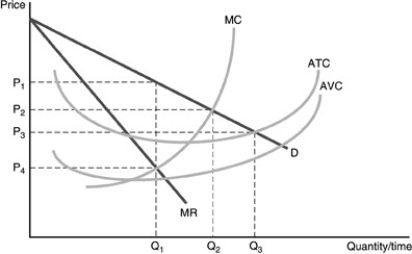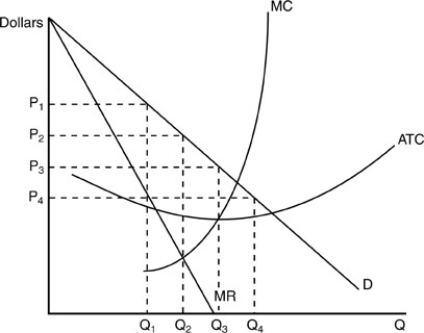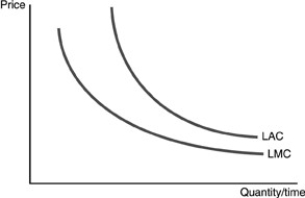A) Ownership of a patent
B) Low cost of obtaining initial capital
C) The presence of economies of scale
D) Government regulation
Correct Answer

verified
Correct Answer
verified
Multiple Choice
Which of the following statements is TRUE?
A) At the monopolist's equilibrium,resources are being efficiently allocated.
B) With a monopoly,the value to society of the last unit produced is less than it's production cost.
C) Monopolists raise the price and restrict production,compared to a competitive situation.
D) A monopolist always produces a higher level of output than would be produced if the market were competitive.
Correct Answer

verified
Correct Answer
verified
Multiple Choice
A monopolist produces in the elastic segment of its demand curve because when it lowers the price,
A) the percentage change increase in quantity demanded is greater than the percentage change decrease in price and total revenue increases.
B) the percentage change increase in quantity demanded is less than the percentage change decrease in price and total revenue increases.
C) the percentage change increase in quantity demanded is greater than the percentage change decrease in price and total revenue decreases.
D) the percentage change decrease in quantity demanded is less than the percentage change decrease in price and total revenue increases.
Correct Answer

verified
Correct Answer
verified
Multiple Choice
-Use the above figure.The profit-maximizing output will be
A) .
B) .
C) .
D) None of the above are correct.
Correct Answer

verified
Correct Answer
verified
Multiple Choice
Barriers to entry enable many monopolists to
A) charge as high a price as they want.
B) make people buy more of a good than they really want.
C) earn economic profits in the long run.
D) manipulate the government into providing special favors for themselves.
Correct Answer

verified
Correct Answer
verified
Multiple Choice
Which of the following are barriers to entry?
A) Economies of scale
B) Patents and copyrights
C) Control of resources
D) All of the above
Correct Answer

verified
Correct Answer
verified
Multiple Choice
To be able to engage in profit-maximizing price searching,a monopoly firm must be able to
A) prevent the entry of other firms into the market for its product.
B) induce the entry of other firms into the market for its product.
C) avoid earning negative economic profits in the short run.
D) always earn zero economic profits.
Correct Answer

verified
Correct Answer
verified
Multiple Choice
When grocery stores issue special discount membership cards for shoppers effectively offering different prices based on quantities consumed,this is an example of
A) price discrimination.
B) price differentiation.
C) product differentiation.
D) patent protection.
Correct Answer

verified
Correct Answer
verified
Multiple Choice
Compared to an efficient perfectly competitive industry,the monopolist will
A) produce less output at a higher total cost.
B) produce less output and charge a higher price.
C) produce more output at a higher price and higher profit.
D) produce more output at a lower price.
Correct Answer

verified
Correct Answer
verified
Multiple Choice
 -Refer to the above figure.The profit-maximizing price and output for this monopolist are
-Refer to the above figure.The profit-maximizing price and output for this monopolist are
A) a price of and output of
.
B) a price of and output of
.
C) a price of and output of
.
D) a price of and output of
.
Correct Answer

verified
Correct Answer
verified
Multiple Choice
Suppose that the profit maximizing level of output for the monopolist is 100 units,and ATC = $45.00; MC = $35.00; MR = $35.00; P = $45.00.What is the monopoly's profit?
A) -$1000
B) $4500
C) $0
D) $3500
Correct Answer

verified
Correct Answer
verified
Multiple Choice
 -In the above figure,if the firm is producing Q1 units at a price P1,the firm should
-In the above figure,if the firm is producing Q1 units at a price P1,the firm should
A) increase output and decrease price.
B) decrease output and increase price.
C) not change output or price.
D) shut down.
Correct Answer

verified
Correct Answer
verified
Multiple Choice
If a monopolist produces to a point at which marginal revenue is more than marginal cost then
A) the firm should increase output.
B) the firm should reduce output.
C) the firm is maximizing profits.
D) we do not know if the firm should increase or reduce without more information.
Correct Answer

verified
Correct Answer
verified
Multiple Choice
A monopolist is defined as
A) a firm with annual sales over $10 million.
B) a large firm,making substantial profits,that is able to make other firms do what it wants.
C) a single supplier of a good or service for which there is no close substitute.
D) a producer of a good or service that is expensive to produce,requiring large amounts of capital equipment.
Correct Answer

verified
Correct Answer
verified
Multiple Choice
A patent provides legal protection for an invention for
A) 20 years.
B) 9 years.
C) 5 years.
D) 3 years.
Correct Answer

verified
Correct Answer
verified
Multiple Choice
A patent on a product gives a firm
A) protection from having the invention copied or stolen for a period of 20 years.
B) economies of scale in producing the product.
C) excessive profits in the long run.
D) the power to impose a tariff on a competing product.
Correct Answer

verified
Correct Answer
verified
Multiple Choice
A profit-maximizing monopolist earns an economic loss whenever
A) it pays taxes to the government on each unit of output it produces.
B) the price it charges for its product exceeds average total cost.
C) the demand curve lies completely below the ATC curve.
D) it produces along the elastic portion of a demand curve.
Correct Answer

verified
Correct Answer
verified
Multiple Choice
Suppose that a drug for treating cancer is cleared by the Food and Drug Administration and that the company is successful in obtaining a patent for its product.Which of the following is then true?
A) The patent holder now faces barriers to entry.
B) The method of producing the product would not be considered intellectual property.
C) The patent holder has a monopoly.
D) The drug would have many close substitutes.
Correct Answer

verified
Correct Answer
verified
Multiple Choice
In a perfectly competitive market,if all firms face identical,constant marginal marginal cost curves,then consumer surplus is
A) the area beneath the market demand curve and above the market clearing price.
B) the area above the market demand curve and above the market clearing price.
C) the total area beneath the market demand curve.
D) definitely zero.
Correct Answer

verified
Correct Answer
verified
Multiple Choice
 -Refer to the above figure.The long-run average cost curve and the long-run marginal cost curves represent
-Refer to the above figure.The long-run average cost curve and the long-run marginal cost curves represent
A) the cost curves for a competitive firm.
B) the cost curves for a natural monopoly.
C) a situation where a firm has control over the raw materials.
D) a situation where a firm has a patent.
Correct Answer

verified
Correct Answer
verified
Showing 161 - 180 of 386
Related Exams